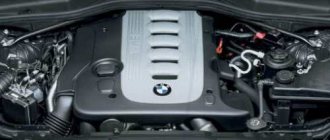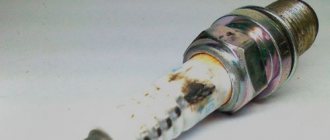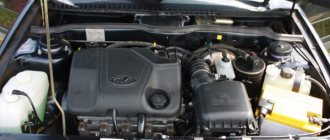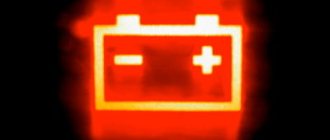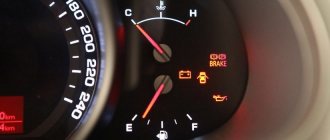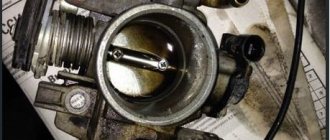On cars of the Samara 2 series, the Volzhsky Automobile Plant installed injection engines with electronic, distributed fuel injection. And for the VAZ 2114, which appeared in 2001, and was launched into series in 2003, such a power plant was developed - model 2111. In subsequent years, various modifications of this car were produced and some of them were equipped with other engine models, such as - 21114, 11183, 21124 and 21126. But the most popular production cars were the VAZ 2114 with engines of models 2111 and 11183.
Engine VAZ 2114
The main distinguishing feature of all engine models on the VAZ 2114 is that they have an injector installed. Electronic control of fuel injection, depending on the readings of a large number of different sensors that monitor a variety of parameters, including the composition of the exhaust gases, of course contributes to balanced and economical operation of the engine.
The engine itself on the VAZ 2114 is an in-line, four-stroke, eight-valve unit with a camshaft located on top. It has four cylinders, runs on gasoline and is cooled with a special liquid. In the engine compartment of a car, the engine is located transverse to the direction of travel. The photo of the VAZ 2114 engine shows its actual location relative to other units.
The cylinder block of this power unit is made of cast iron. All holes for antifreeze are formed in the casting mold, the oil passages are machined mechanically. The working cylinders are also machined. At the bottom of the block there are main bearing supports; covers for them are made during the manufacture of the block; they have an individual fit, so they cannot be replaced. When disassembling, you need to pay attention to the markings of these covers so as not to confuse them.
. Inserts made of an alloy of steel and aluminum are inserted into the covers and supports. Thrust half-rings are inserted into the third support, which prevent axial movement of the crankshaft.
The pistons are made of aluminum with steel rings cast into them. The pins are floating and the connecting rods are forged from steel. The bottom of the cylinder block covers the pan; there must be a gasket between them. Its integrity must be monitored, because the pan is a container for engine oil, which lubricates all rubbing parts during operation of the internal combustion engine. The lubrication oil system operates under pressure and spray. The pressure is created by an oil pump, which, taking lubricant from the sump, drives it through a direct-flow oil filter. It has a check valve that prevents oil from flowing back into the pan.
The crankshaft, located at the bottom of the cylinder block, has a flange. The flywheel is attached to this flange. A special installation mark is made on the flywheel by drilling for its correct location on the crankshaft flange. This mark should be located opposite the connecting rod journal of the fourth cylinder.
A pump, also called a coolant pump, is installed on the left side of the internal combustion engine cylinder block.
The cylinder head, or cylinder head, is made of aluminum. The cylinder head contains valves with bushings and seats and pushers with adjusting washers. The camshaft is located in the cylinder head from above and is clamped by supports to which the bearings are pressed. The cylinder head is closed with a cap with a neck for filling oil.
The camshaft and pump are driven by a belt from the crankshaft toothed pulley. Nearby there is another belt that spins the generator.
Technical characteristics of the VAZ 2114 engine model 2111
- ICE type - in-line;
- four cylinders, two valves per cylinder;
- cylinder diameter - 82 mm;
- compression ratio - 9.8;
- ICE volume - 1.5 liters;
- engine power - 78 hp. With.;
- maximum torque - 116 Nm at 3000 rpm;
- average fuel consumption in mixed mode is 7.3 liters per 100 km;
- ICE weight - 127 kg;
- the service life of the power propulsion system is 150 thousand kilometers, during practical operation the service life reaches 250 thousand kilometers;
- real engine tuning is possible in various ways and without loss of service life the power can be increased to 120 hp. s., there is the potential to increase the power of the internal combustion engine to 180 hp. pp., but with a significant loss of power plant life.
VAZ 2114 engine repair
During the operation of the internal combustion engine on a car, various failures and malfunctions may occur, which can be eliminated by self-repair or with the involvement of specialists. The need for a major overhaul of the power propulsion system, with its proper operation, arises when the mileage reaches 150,000 km. In this case, a VAZ 2114 engine overhaul is needed.
- Before you begin disassembling the engine, you need to drain the oil and coolant, and then wash the entire unit. Be sure to remove all attachments so as not to damage them during reassembly.
- Disconnect all pipes through which gasoline is supplied.
- Remove all systems and components related to the air supply, remove the air supply and exhaust hoses and pipes.
- Remove the cooling system pipes and crankcase breather. Don't forget to disconnect the throttle pipe.
- Remove the receiver, as well as the pipeline mounting bracket and the fuel rail, remove the injectors with regulators.
- Remove the wires with the ignition module and knock sensor. Unscrew the spark plugs. After this, unscrew all sensors.
- Remove the generator by first removing the tension belt. With the generator, remove all brackets and strips necessary for its installation and adjustment.
- Block the flywheel and remove the generator pulley.
- Remove the camshaft drive with the cover, tension mechanism and pulley.
- Unscrew the pump, remove the exhaust manifold and thermostat.
- Disconnect the oil filter and oil sump, then remove the oil pump.
- In order to remove the piston group, you need to unscrew the nuts from the connecting rod bolts and remove the cover.
- Since the flywheel is blocked, you need to unscrew its fastenings with the flange and remove the flywheel disk.
- Remove the caps from the main bearings along with the lower bearings.
- Carefully pull out the crankshaft. It must be handled very carefully to prevent damage and scratches.
- Remove the upper liners and thrust half-rings.
When overhauling an internal combustion engine, it is necessary to carefully inspect each unit, component or part. If mechanical damage is detected, the spare part must be replaced. All gaskets, washers and non-metallic parts also need to be replaced.
The VAZ 2115 is equipped by the manufacturer with two types of 1.5i liter engines. and 1.6i l. In principle, the engines are identical, the fundamental difference is only in the working volume of the engine. If the injection engine of the VAZ 2115 is not working, then it’s time to seek advice from specialists or read the information below.
The engine does not pull: the main reasons for the decrease in engine power
So, if no other symptoms other than loss of traction are detected, then you immediately need to pay attention to the quality of the fuel, the proper functioning of the ignition and power systems. As practice shows, more than half of the cases of reduced efficiency from internal combustion engines are associated with fuel
The engine does not turn on due to the fact that the tank may be filled with low-quality or unsuitable fuel for this type of engine (for example, 92-grade gasoline instead of 95-grade gasoline)
As practice shows, more than half of the cases of reduced efficiency from internal combustion engines are associated with fuel. The engine does not turn on due to the fact that the tank may be filled with low-quality or unsuitable fuel for this type of engine (for example, 92-grade gasoline instead of 95-grade gasoline).
In some cases, after refueling, problems may also arise with starting the engine, and engine detonation may occur. To solve this problem, it is often enough to dilute the existing fuel with a higher quality one. Less often, it becomes necessary to completely drain the fuel from the tank, after which additional flushing of the power system is performed.
Typically, such manipulations are necessary when, parallel to the loss of traction, unstable operation of the internal combustion engine is noted, the speed jumps or floats at idle and under load, the engine does not start easily, the “check” light is on the panel, etc.
Also, owners of gasoline engines can independently determine the quality of gasoline by the spark plugs and their appearance. To check the spark plugs you need to unscrew them from the engine. A disruption in the combustion process of the fuel-air mixture in the cylinders, as well as the presence of impurities in the fuel, can be identified by soot on the spark plugs and its color.
For example, if the fuel contains a lot of third-party metal-containing additives and additives, then the skirt and electrodes may become covered with reddish soot (brick-colored). Black soot will indicate that the fuel is not burning properly, etc. In any case, malfunctions in the combustion process of the working mixture lead to the fact that the engine stops pulling.
The next step in diagnosis is checking the spark plugs. A decrease in the efficiency of these elements is also accompanied by a decrease in the power of the power unit.
This is especially noticeable during sharp accelerations, and when the car is already moving at high speed. In other words, the motor has no “reserve” left for further acceleration.
The candles may be dirty, and it is also possible that their life has come to an end. To fix this problem, you can clean the spark plugs or immediately replace the entire set with a new one.
It is important to take into account that if new spark plugs are correctly selected for a specific engine in terms of heat rating and other parameters, but still quickly become dirty, then the reason for the loss of traction is not in them. The formation of carbon deposits in this case indicates problems with mixture formation or combustion of the fuel charge in the cylinders
If everything is in order with the spark plugs, then you need to check the condition of the fuel and air filters. In the first case, insufficient throughput can lead to the fact that the required amount of fuel is not supplied to the cylinders to prepare the so-called “power” mixture.
As a result, the engine loses power, that is, it does not pull under load. In such a situation, it is enough to replace the specified filter element. As for the air filter, the problem is similar to the fuel filter, but in this case there is a lack of air in the fuel-air mixture.
This leads to the fact that fuel without a sufficient amount of oxygen burns incompletely. In such conditions, engine power naturally drops, carbon deposits form in the combustion chamber, spark plugs become increasingly dirty, etc. To solve the problem, the engine air filter also needs to be replaced.
How to understand that the engine is troit
In principle, every car owner, even if it is his first car, knows it well. And it will be able to determine (by sound, for example) that there is a malfunction in the car. You can determine that the engine in a VAZ 2115 is faulty by the following “symptoms”:
When idling, the car experiences very noticeable vibrations. The engine operating cycle has changed (the sound of its operation will change), when you press the accelerator pedal, the car does not accelerate, this phenomenon may be accompanied by loud pops in the exhaust pipe and in the air filter. Increased fuel consumption as it does not burn. If the car owner notices such changes in the car’s operation, he must immediately contact the service center to eliminate them. Because initial repairs will be several times cheaper than repairs at an advanced stage.
But today we’ll look at why the engine is tripping. Many drivers nod their heads in agreement when they are told by the service center that the engine is misfiring, without understanding the essence of this phenomenon. Troit means that at least one cylinder is not working in the engine. This could be due to several reasons, which we will now look at.
Why troit 2115
What does “TROIT” mean - this means that one of the cylinders is not working, in total there are 4 cylinders in the 2115 engine, when one of them fails, it turns out that only 3 cylinders are working, which is why they say that the engine is troiting.
Sometimes it happens that two cylinders on a car stop working at once, then it turns out that the engine is running double, but no one says that, everyone says that the internal combustion engine is running triple. There may be several reasons why the VAZ 2115 starts to triple and all of them, as a rule, are located in one place on the cylinder head.
The most common causes of VAZ 2115 engine tripping:
- Spark plug;
- High voltage wires;
- Ignition module;
- Crankshaft position sensor;
- Fuel injectors;
- Air leak;
Each of these parts or causes can seriously affect the performance of the engine and lead to the failure of one of the cylinders. Let's look at each of the reasons in more detail.
Spark plug
One of the most common reasons why a car starts to misfire is the spark plugs. According to the regulations, it is recommended to replace spark plugs no later than 30,000 km, which few people comply with, and sometimes they drive on spark plugs until they completely fail.
After prolonged use, spark plugs lose their properties, the gap between the electrodes increases, carbon deposits appear, the insulator cracks, etc. which leads to spark plug failure and, consequently, engine failure.
If the engine in your car starts to misfire, the first thing you need to do is replace the spark plugs with new ones; this will never be a bad thing, even if the reason is not them.
How to identify the causes of engine tripping
The VAZ 2115 injector has “childhood diseases”, like all cars in principle. We'll talk about this a little later. The first step is to inspect the spark plugs. By removing the caps of the high-voltage wires one by one, you can determine which spark plug is not working; if the sound and rhythm of the engine does not change, it means that a faulty spark plug has been found and must be replaced. This operation must be performed with great care, as it may cause severe electric shock. The next reason is high-voltage wires. The engine is hot, the insulation of the wires is destroyed, and the wire begins to break through. Plus, sadly enough, the quality of spare parts is low. Only complete replacement of high-voltage wires helps in solving the problem.
You should also pay attention to the coarse fuel filter, which is located in the gas tank. This malfunction is also determined by the service. The VAZ engine may fail due to a burnt-out valve, and this is the saddest reason. You should go to the service center to measure the compression in the cylinders, because you won’t be able to do the procedure alone, you need an assistant who will turn the engine start key, and you should take into account that you will need a compression gauge, an ordinary car user does not need one, but the service center definitely has one.
If the compression is significantly lower in one, the valve is burnt out. The phenomenon is sad, but not so rare. Fixed in the service.
It would be a good idea to pay attention to the coolant level. After all, when the cylinder head gasket breaks, the engine also begins to suffer. When the cylinder head gasket is punctured, engine coolant enters the cylinders, mixing with oil to form an emulsion visually similar to condensed milk. Moreover, the gasket may be pierced along the contour of the engine water jacket, or it may burn out due to exhaust gas breakthrough, this does not change the essence. If it has been bad for a long time, but you still continued to drive the car, then just pull out the oil level dipstick, and this emulsion will be visible at its tip. At the same time, the coolant level in the engine drops. Eliminating this cause is technologically similar to repairing a burnt-out valve. Only service, and a good specialist. In general, on a VAZ 2115 engine, the injector valve adjustment should be constantly paid attention to and adjusted every 10,000-15,000 km. mileage
The VAZ 2115 engine can stall even for no apparent reason
Defeated tripping at idle
For the sake of decency, I read all sorts of forums, but didn’t find anything sensible about my problem. Everyone changes everything as one, but the problem does not go away.
By the way, when driving the car behaves adequately, a little worse than before, but at idle it’s an ambush. I noticed that when I released the gas, the revolutions dropped very quickly by 800, sometimes by 500, and then leveled off again at 800. The XX revolutions did not float, they stayed almost rooted to the spot, and the engine was unstable like a child. I brought the laptop into the car, connected, looked at the parameters, in principle everything was normal, maybe the IAC had a few steps, but not critical. The injection time correction coefficient was 0.984, the injection time itself was approximately 2-2.5 ms, that is, normal for simultaneous injection. The UOZ was jumping, well, that goes without saying, the engine is churning, so it jumps.
The simplest thing was of course also done, I unscrewed the spark plugs, they were all in good condition, no oil, no gasoline, no carbon deposits. I also grounded all the explosive wires, all the sparks are strong, and all the boilers are working. I took off the timing case, the marks are in place, the 20th tooth of the generator pulley opposite the crankshaft sensor, everything is as it should be. I was already upset, thinking that either some valve was burning out, or the gasket between the cylinders had broken. With these thoughts I finished the renovation. The next day I went to the store and finally bought myself a compression gauge, I had been wanting it for a long time, and then the opportunity came up.
I measured the compression, it certainly made me happy and sad at the same time: it was 12-11-11-10. When the outside temperature reaches +20, I’ll start adjusting the valves, they seem to be tight. Well, since the compression is non-zero and more than 10, then the valve is clearly not burned out and the gasket is intact. I breathed a sigh of relief) By the way, if you, like me, are a single repairman, then it’s easy to measure the compression alone) Warm up to operating temperature, unscrew the spark plugs, do something like this with the throttle
We remove the chips from the injectors and the ignition module and most importantly: the red wire, which is also positive, fits into the starter solenoid relay, replace that wire with something like this
Well, then we screw in the compression gauge and connect this wire to the battery positive, the starter turns successfully, the spark plugs and injectors are silent and we calmly take readings.
Let's move on, the problem remains as it is. The search continued. I removed the IAC, there was little soot, I blew it all off with a carb cleaner and stuck it in place. Zero effect as expected. Then, with the engine running, he put his head almost on the valve cover, abstracted himself from the tractor sounds, and thought he heard a subtle hiss.
Let me remind you that the injection time correction coefficient is 0.984, which doesn’t look like air leaks at all. Well, out of desperation, I took the same carb cleaner and started spraying it. The VUT valve is ok, but the injectors are not at all ok. 3 of the 4 injectors quickly sucked in the cleaner through the rings on the manifold and dried out almost instantly, only one remained wet, and the sound of the engine did not change at all. It’s already warmer) Although I changed the rings a year and a half ago.
I went to the store and bought new ones, better than last time. Balakovsky ones with graphite coating) This made me happy) Well, then everything is simple, we take out the ramp, I didn’t take a photo of this thing, my hands were all dirty and covered in gasoline. Naturally, the ramp with nozzles came out very easily. After analysis, the verdict: the upper rings are good, soft, the lower ones became stiff after a year and a half. Before reinstalling, I washed the injectors just in case, since I removed them. This is such a stray.
The syringe has 5 cubes, without a ring, the nozzle fits well with a little tension, there is enough pressure. The forces were clean, they became even cleaner) Then I put the whole thing back together, started it and received the long-awaited satisfaction of my successful work. In total, I bought a compression gauge for 500 rubles and a carburetor cleaner with rings for 170 rubles and not a single sensor. Thank you all for your attention and don’t rush to change everything, the problem can be much smaller and cheaper. If only I could find her.
Childhood diseases of the VAZ 2115 engine
Well, about the above childhood diseases of the VAZ 2115 injector. One of the reasons is a non-working injector. The injector nozzle itself may either fail, or there may be a power cut to it. Next comes the crankshaft sensor. There is an opinion that the crankshaft sensor either works or not. Practice proves that it can show a completely different picture of performance, not only on the VAZ 2115, but also on other cars of this brand. But what is true is that it cannot be repaired, but must be replaced. And finally – the ignition module. If an accident happens to you on the road, you can only determine if the ignition module is faulty by removing the same module from the working vehicle and connecting it to yours. Well, then, follow to the service.
Spark plugs are to blame
Most likely, the cause of the engine tripping is the spark plugs. In order to verify this fact, you should unscrew the spark plug from the cylinder and carefully inspect it. If the engine is operating correctly, the color of the side electrode, as well as the insulator, will be quite light. A brown tint is also allowed. A spark plug in this condition should be fully functional. But if the carbon deposits on the candle turn out to be black, then it simply cannot be working. It is either enriched with fuel or filled with oil.
Due to carbon deposits formed on the spark plug, it may not work at all or only work occasionally. Both the first and second options interfere with the normal formation of a spark.
The reasons for the appearance of carbon deposits on candles may be:
- the car engine has been idling for a long time or has been warming up for a long time;
- there is reduced compression in the cylinder;
- valve timing is shifted or disturbed;
- the injector is not working correctly;
- The oxygen sensor is faulty.
Next, it is imperative to pay attention to the housing in which the spark plug itself is placed. It should be completely white, without black dots or stripes. If, nevertheless, stripes or dots are visible on the body, this indicates that the spark plug is breaking through normally, but will not work.
But if, after inspecting the spark plug housing, nothing of the kind was found, you should check the spark while cranking the starter. To do this, a spark is inserted into the tip of a high-voltage wire and placed on the engine ground. The engine is cranked by the starter. At this time, you need to see if a spark jumps between the two electrodes of the spark plug. If it is visible to the naked eye and has a pronounced blue color, the candle is working correctly.
conclusions
The bottom line is that it can be emphasized that the following malfunctions may be the reasons for the VAZ 2115 engine to fail:
Spark plugs High voltage wires. Coarse fuel filter Burnt valve. Blown cylinder head gasket Injector Crankshaft sensor. Ignition module.
- Candles
- High voltage wires
- Coarse fuel filter
- Burnt valve
- Blown cylinder head gasket
- Nozzle
- Crankshaft sensor
- Ignition module
Having discovered any of them, the car owner needs to contact a service center, where specialists will accurately determine the nature of the breakdown and be able to fix it. If the VAZ 2115 engine is malfunctioning and you do not have the proper experience, then you should not carry out repairs yourself, this can lead to an even greater deterioration in the condition of the car or injury to the technician himself!
Content
As part of the renewal of the LADA Samara family, the Volzhsky Automobile Plant released the VAZ-2115 in 2000 as a replacement for the popular VAZ-21099 sedan. The model received a completely new front end with new optics, a roof of a different design, new front fenders, an improved interior and more reliable electrical equipment. In 2008, the VAZ-2115 underwent a small facelift to “refresh” the appearance of the car.
Production of this model was completely discontinued in 2012 - it was replaced by the more modern LADA Granta.
Valve clearances
Many may argue that this cannot be the cause of tripling. But there was a case in my practice when a car arrived to us, without an ECU, an on-board computer with a carburetor - a VAZ 2107. The power unit was severely troubled only when “cold”. After warming up the engine ran smoothly.
All systems were checked and no comments were found. We were the same skeptics. But we still decided to check the gaps - the dipstick did not want to fit in. We set the correct gap, the engine began to run smoothly in any condition - cold, hot.
What to do
If the engine is not equipped with hydraulic compensators, then you need to check the thermal clearances of the valves. For the future, in such power units it is necessary to adjust the valves after 15-20 thousand mileage.
This is especially true for the use of HBO. In this case, you can get a burnt valve and repair the cylinder head.
In case of engine tripping, you need to check the thermal clearance of the valves. On VAZ 2107 engines, the gap is checked with a feeler gauge
VAZ-2115 1.5 injector
Despite the fact that the car was initially planned to be equipped with a 1.5 liter carburetor engine, when the model was put into production, it was decided to equip it with a new VAZ-2111 injection engine with a volume of 1499 cm3. This engine developed a power of 78 hp. and a torque of 116 Nm and was significantly more economical than a carburetor. Production of the VAZ-2115 with this engine continued until 2007.
Gasoline consumption VAZ-2115 1.5 injector per 100 km. Reviews
- Sergey, Kurgan. I have a VAZ-2115 with a 1.5 liter engine, 2006. Elki, if I had known that a more powerful version would be released in a year, I would have waited. The one and a half liter engine is somehow unfinished, there are always problems with it, but everything is fine with consumption - 10 liters in the city, 7 liters on the highway.
- Semyon, Omsk. I bought the car in 2003 - just to replace my old Nine. I will say this - the only difference is the appearance, in everything else - all the same wood, only in profile. Consumption on average is 9 liters, the suspension at first pleased with its softness, but then died quietly, like the clutch. In general, everything needs to be improved.
- Yuri, Barnaul. "Fifteen" 2002, 1.5 liter engine. I had been dreaming about a car for a long time - but I didn’t have the main thing to realize my dream - money. I really wanted to buy a Camry in the 40 body, but where did the hard worker get that kind of money? Having saved up, I decided to take a domestic car - for example, a VAZ-2115. I had it for 3 years and it was three years of constant repairs in my father’s garage. The only things that didn't break were the glove compartment and the steering wheel. And I think the consumption in the city of 10-11 liters is a lot for a 1500 cc engine.
- Yuri, Gorno-Altaisk. In the reviews, everyone criticizes the domestic auto industry. In their own way, they are right, but if you want to buy a new car and inexpensively, this is the only option. At one time, in 2005, that is why I bought a VAZ-2115. Then they were produced with a 1.5 liter engine. Well, it’s a normal car, it didn’t hover at all for 2 years, then I used it for another 2 years and sold it, so there weren’t any special problems. And the consumption is reasonable - 8-9 liters in the city, like most foreign cars with this volume.
- Igor, Dmitrov. The car was purchased with a mileage of 110 thousand km. At first I couldn’t understand anything - the consumption in the city is about 13-14 liters, and we have no traffic jams or hassles on the road. At first I sinned on bad gasoline, but then I went to a service station, they cleaned the fuel, injectors, and so on - the consumption dropped to normal 9-10 liters per 100 km.
- Konstantin, Moscow. I don’t know who it is, but for me, the VAZ-2115 is a fairly economical car. I drive in such a way that I don’t get stuck in traffic jams; in the summer, my consumption is from 8 to 11 liters in the city; on the highway it’s no more than 6 liters.
- Oleg, Petro I fill up with 92nd gasoline - there is practically no difference in consumption and dynamics with 95th, but the price is still different. In my city it comes out to 9-10 liters, if I come to St. Petersburg on business, then generally up to 13 liters. On the highway from 5.5 to 6.5 liters, depending on the speed.
- Sergey, Volgodonsk. I bought my VAZ-2115 in 2005. Probably, I came across some kind of exception or the stars lined up on the day of assembly, but for 7 years of owning the car there were no problems with large components (box, engine, clutch, etc.) at all. Only maintenance and minor work on the undercarriage. And the consumption is 9 liters in the city, no more.
- Dmitry, Penza. I have a VAZ with an eight-valve engine with 1500 cc. I like the fact that I don’t have much of a difference between summer and winter, like on many foreign cars - in the summer 9 liters in the city, in the winter 10 liters, maximum 10.5 liters if it’s very cold. By the way, I use a car blanket in cold weather, it’s a very good thing.
VAZ-2115 1.6 injector
Since 2007, the VAZ-2115 began to be equipped with a more powerful and modern 8-valve 4-cylinder engine VAZ-11183 with a volume of 1.6 liters. This engine had a power of 82 hp. and torque increased to 120 Nm, but the main thing is that it was even more economical and reliable than the VAZ-2111 engine.
Fuel consumption VAZ-2115 1.6 injector per 100 km. Reviews
- Ivan, Tomsk. VAZ-2115 was my first car - I bought it in 2010. Engine 1.6 injector, wet asphalt color - not a car, a dream. The engine started perfectly even in severe frost, there were no problems with it. Moreover, the consumption is moderate - on the highway 5.5-6.0 liters, in the city up to 10 liters in winter.
- Kirill, Krasnodar. The car was purchased in 2014 at a dealership with a trade-in. Who can say why a VAZ and not a used foreign car - because for 180 thousand you won’t buy an almost new car. I liked the consumption - it comes out to 5.5 liters on the highway, and not 95, but 92 gasoline, in the city from 9 to 10 liters.
- Satar, Moscow. Lada VAZ-2115, 1.6 engine, 2007. I bought the car from my father - he was switching to a Duster, and he offered me to buy his car. Well, it would be stupid not to take it - it’s in excellent condition, my father literally licked it, so he didn’t even think about it. The average consumption was 10-11 liters, but just before I was planning to sell it, the consumption began to slowly increase, and it came out to at least 12 liters.
- Pavel, Kyiv. The only reason I drive a VAZ-2115 is the low price of spare parts and low consumption on the highway. I get about 5.5 liters, and I go 120-130 km/h. It is difficult to find a Lanos with such an engine in good condition, and the Sens is not even close to the “tag”.
- Anatoly, Nalchik. You can’t really accelerate here - second or third, except that outside the city you can turn on fourth or fifth. Therefore, consumption is always higher than in any other city. But on my VAZ-2115 the consumption of more than 10-11 liters in the city never rose, and outside the city it was 6-7 liters, no more.
- Vladimir, Moscow. VAZ-2115 (Samara-2), 1.6 liter injection engine with 81 hp, 2011. A normal car even for Moscow - no worse than all sorts of Solaris and Aveos, and in terms of price and fuel consumption it is much more profitable. My consumption in Moscow in traffic jams reached a maximum of 15 liters - my friend’s Toyota is consistently 20-22 liters. And if you travel outside the Moscow Ring Road, then 5.5 liters, no more. The only negative is that it’s scary to drive more than 130 km/h, it’s very light.
- Andrey, Kirov. I bought my VAZ-2115 three years ago at a dealership. Four months later the rear struts began to leak, and six months later the transmission and pump failed. And this is in a new car! What is this called? The only thing that was normal about it was its consumption - it was not small, but at the level of its classmates, from 6 liters on the highway to 11 liters in the city.
- Alexander, Yaroslavl. A normal car for the money. If you look after her, she won’t create any problems. And if a person constantly puts the pedal to the floor, then he does not do it as needed, but when there is money, it is natural that the car will go down quickly. In terms of consumption - although the engine is eight-valve, it consumes a little. In the city, 9.5 liters in summer and 11 in winter (this is the maximum), highway from 5 liters (90 km/h) to 9 liters (130-140 km/h).
- Evgeniy, Krivoy Rog. The only thing I don't like about the "tag" is that it is light. If you go on the highway at a speed of 130 km/h, then it starts to throw, it’s downright scary. If there are a couple of people in the car and there is some kind of cargo in the trunk, then of course you drive more confidently, but the consumption also rises to 8.5 liters.
Many motorists, especially beginners who have just purchased a VAZ-2114, have wondered how the 8-valve injection engine that is installed on this car works. This article will discuss the design of the motor, its main characteristics, as well as dismantling and repair features. This information will be very useful for beginners and those who do not know how the main power unit works.
Video about the VAZ-2114 engine
Video review of the VAZ-2114 engine operation, features and characteristics.
Engine diagram and structure
General view of the engine
Before we begin to consider the issue of the engine design and description of the characteristics, it is necessary to consider the design of the components and parts that are located directly in the main power unit and outside.
Diagram and design of the Samara-2 engine
1 – generator drive pulley; 2 – oil pump; 3 – timing belt; 4 – toothed pulley of the coolant pump; 5 – front cover of the timing mechanism drive; 6 – tension roller; 7 – camshaft toothed pulley; 8 – rear cover of the camshaft drive; 9 – camshaft oil seal; 10 – cylinder head cover; 11 – camshaft; 12 – front cover of camshaft bearings; 13 – pusher; 14 – valve guide; 15 – oil separator mesh for the crankcase ventilation system; 16 – exhaust valve; 17 – inlet valve; 18 – rear cover of camshaft bearings; 19 – fuel pump; 20 – housing of auxiliary units; 21 – ignition distributor sensor; 22 – outlet pipe of the cooling jacket; 23 – cylinder head; 24 – spark plug; 25 – crankcase ventilation hose; 26 – flywheel; 27 – crankshaft rear oil seal holder; 28 – ; 29 – cylinder block; 30 – oil pan; 31 – oil level indicator (oil dipstick); 32 – crankshaft; 33 – piston; 34 – connecting rod cover; 35 – connecting rod; 36 – crankshaft main bearing cover; 37 – ; 38 – .
Also, it’s worth looking at a cross-section of the VAZ-2114 engine:
Cross section of the Samara engine
1 – oil pan drain plug; 2 – oil pan; 3 – ; 4 – coolant pump; 5 – exhaust manifold; 6 – intake manifold; 7 – carburetor; 8 – fuel pump; 9 – cylinder head cover; 10 – camshaft bearing cover; 11 – camshaft; 12 – crankcase ventilation hose; 13 – valve adjusting washer; 14 – pusher; 15 – valve cotters; 16 – valve springs; 17 – oil scraper cap; 18 – valve guide; 19 – valve; 20 – cylinder head; 21 – spark plug; 22 – piston; 23 – compression piston rings; 24 – ; 25 – piston pin; 26 – cylinder block; 27 – connecting rod; 28 – crankshaft; 29 – connecting rod cover; 30 – oil level indicator; 31 – oil pump receiver
Characteristics of an 8-valve engine
Many motorists remember how at the end of the 90s of the 20th century and the beginning of the 2000s, the VAZ 2108-09, which was also called “Samara,” was popular on the roads of the CIS. These cars became legendary in that era. Due to the high popularity, the AvtoVAZ plant decided to resume production of these models with some modifications.
VAZ-2114 engine under the hood
Firstly, the VAZ-2114 received a modified engine
. In essence, this is an injection version of the Samara. Although it received some features from modern engines. If we consider in more detail, the Samara-2 engine (this is the type installed on the VAZ-2114) is a mixture of two engine options into one: from the VAZ 2108 and VAZ 2110.
Many motorists liked the Samara-2 power unit and fell in love with it. The main indicator was ease of repair and inexpensive spare parts. Thus, the 8-valve engine has become the standard for “price-quality” indicator.
When the basic information has been reviewed, you can proceed directly to considering the characteristics of the motor.
Table of main characteristics of the Samara-2 engine 8 valves:
| Name | Characteristic |
| engine's type | In-line, longitudinal type, 4-cylinder, 8-valves |
| Fuel type | Gasoline (installation of gas equipment is possible) |
| Cylinder arrangement | 1-4-3-2 |
| Injection system | Distribution, injection type |
| Control | Bosch, "January" or GM |
| Camshaft location | Upper |
| Drive unit | Front |
| Piston and ring diameter | 82 – nominal (tolerances by group: A – 82.00-82.01, B – 82.01-82.02, C – 82.02-82.03, D – 82.03-82.04, E – 82.04-82.05) |
| Crankshaft | Cast iron |
| Cylinder block | Cast iron |
| Timing system | Belt and roller |
Disassembly and repair: basic facts
Therefore, let’s consider the main operations aimed at removing the engine from the car:
- At the preliminary disassembly stage, it is necessary to remove coolant from the system.
- Another point that should not be missed is turning off the power to the car. This is necessary in order not to short-circuit the system.
- Disconnect the fuel system.
- We dismantle the components that supply air to the engine.
- Disconnect the throttle, as well as all remaining air pipes and cooling system pipes.
- We dismantle the injection system and receiver.
- We film completely.
- Let's disassemble the gas distribution mechanism.
- and a pump.
- Now, you can dismantle the collector.
- Remove the pan, oil filter and pump.
- Disconnect the gearbox and remove the clutch. The gearbox can also be removed for convenience.
- Remove the cylinder head.
- We dismantle the power unit.
- We carry out final disassembly.
A major overhaul of the power unit will require more in-depth knowledge of the design and operating principle of the engine, but if desired, every motorist is able to understand this and carry out these operations with his own hands.
It is worth noting that when diagnosing malfunctions, it is worth carefully and carefully inspecting each part for defects.
conclusions
The design of the 8-valve injection engine VAZ-2114 is quite similar to the first generations of this engine - “Samara”. Of course, the designers made many changes to the features of the power unit, but in many ways they remained similar. Repair and maintenance of this engine must be carried out regularly, which will also reduce wear on the parts located inside.
Many motorists have encountered problems with the engine of a VAZ 2115. The reason, as in all cases, is the formation of an air-fuel mixture or the lack of a spark in one of the cylinders. This article will tell you how to fix this problem.
Timing marks
If the camshafts are incorrectly aligned relative to the crankshaft
– the reason for the engine tripping. The opening and closing timing of the intake and exhaust valves will not coincide with the engine strokes.
For example, at TDC of the piston the valve may be closed, so a flash will occur not only in the cylinder, but in the intake or exhaust manifold, depending on which valve is not closed.
This may occur due to a stretched timing drive.
. As the chain or belt is used, it stretches. Therefore, the opening or closing angles may shift. This leads to engine tripping.
What to do
If you have checked everything: the spark plugs are in order, there is a spark everywhere, the quality of the mixture is at the right level, you need to check the timing marks. We look at the degree of belt tension. In the case of a chain, how “out” the tensioner is. If the marks are knocked down, then we set them as needed.
Correctly set marks on the camshaft of a 16-valve engine
After troubleshooting, we fix the problem. If the motor stops running, the cause has been found and eliminated.
Causes of malfunction
Before we begin to analyze the issue, it is worth understanding that the power unit requires certain components in order to function. An engine requires four components to run properly: air, fuel, spark and functioning electronics.
Based on this, you can determine exactly where the fault may be hidden and identify the main components. The VAZ 2115 engine is having problems with the 8-valve injector, where to look for the reasons:
- Sensors and ECU.
- Fuel, as well as its supply components.
- Air.
- Sparking.
Elimination methods
To correctly find the problem and fix it, the motorist should have knowledge of the design of the engine and its systems, as well as have the tools. A very indispensable element is time and hands growing from the right place. So, now you can begin to analyze the processes aimed at troubleshooting the problem.
Sensors and ECU
So, first you should connect to the electronic engine control unit and carry out diagnostics using special software. The vehicle owner will need a USB-car cable, called K-line or OBD II, a tablet and the appropriate software.
After connecting and identifying the automotive equipment, it is worth carrying out diagnostic operations. If a software failure is detected, it must be removed and the system restored to functionality.
Also, the diagnostics will show which of the sensors has lost its functionality.
Which sensors are responsible for the normal operation of the engine, and their failure can lead to tripling of the power unit:
- Idle speed regulator. If this meter fails, then the engine will run cold. In this case, the engine will not only stall, but also have difficulty starting.
- Mass air flow sensor. Quite an expensive part in any car. Often, it does not fail, but the measuring grid becomes clogged. To restore operation, you need to clean the mesh.
- Crankshaft position sensor. It measures the number of engine revolutions, thereby regulating the supply of the amount of fuel mixture.
- The coolant temperature sensor affects the operation of the system indirectly, but can affect and create artificial tripping.
Fuel and its supply components
An integral element in the formation of the air-fuel mixture is fuel. So, not enough of it leads to the formation of a lean mixture, but too much of it leads to a rich mixture, which can flood the system.
The first thing you need to start diagnosing is the pump and filter. Clogged elements can lead to insufficient fuel reaching the injectors. The gasoline pump is located under the rear sofa, where it is quite easy to reach, but the filter element is mounted on the bottom behind the right rear wheel.
An injector is a fuel element that sprays fuel. The clogging of this unit affects the amount of fuel injected into the combustion chambers. Therefore, it is necessary to carry out diagnostics quite often. This is done using a special stand. If necessary, it is worth replacing the elements.
Air
Air supply elements are quite important because they directly affect the formation of the air-fuel mixture. So, a clogged throttle valve or its jamming will cause the car to suffocate, which will lead to the effect of tripping or it will stall. To clean this unit, it is necessary to dismantle the entire throttle valve. The part is cleaned using carburetor cleaning fluid.
An important element is the air filter. If it has not been changed for a long time or it is clogged ahead of time, then a tripping effect may be created. To eliminate the malfunction, you need to replace the dirty part with a clean new element.
Sparking
The last component that is involved in the normal operation of the engine is the spark generator. This unit includes: spark plugs and high-voltage wires.
Often, due to improper operation of the injection system, the spark plugs will either burn out or be flooded with gasoline, which makes it impossible to ignite the fuel normally, since there is no space between the contacts.
To diagnose and fix the problem, you need to unscrew the elements. To do this, remove the tips of the high-voltage wires from the spark plugs. And then, using a spark plug wrench, unscrew the elements. So, by examining each candle you can determine what condition it is in.
If there is no spark plug tester to check the spark, then you should turn to the “old-fashioned” method and do it by car.
With high-voltage wires everything is simpler. They should be removed from the engine compartment. To do this, disconnect the tips from the spark plugs, and then from the ignition coil. The elements are checked using a multimeter. On the tester you need to set a resistance “measurement” and measure each wire. The indicator should be around 5 ohm. If the deviation is too large, the wire must be replaced.
Replacement, performance check
For ease of access to the DS, it is better to drive the car into a pit or overpass, since it is easier to reach it from below. The only tools you need are 21 (22) and 10 keys, as well as a flat-head screwdriver.
You need to unscrew the DS counterclockwise. Since the sensor body is plastic, it can often be unscrewed by hand, but you may need to slightly loosen the fastening with a 21 (22) key.
We screw a new DS in place of the removed one, making sure that its pin fits into the hole in the actuator rod.
There is no need to tighten it with a wrench so as not to break the plastic thread; hand force is enough.
Sometimes problems with the operation of the sensor are not related to it, but to the drive. The fact is that some models use a plastic drive rod gear, and often its teeth “lick” themselves.
Therefore, when replacing the DS, it would not be superfluous to check the condition of the drive. To do this, after removing the sensor, you need to unscrew the drive mounting nut with a 10 mm wrench and carefully remove it, prying it slightly with a screwdriver.
It is important to ensure that the shock does not jump out and get inside the box.
After making sure that everything is in order with the drive gear, we install everything in place. Then we check whether the gears are engaged.
To do this, we jack up one front wheel, turn on speed 4 and ask an assistant to turn it, while we ourselves check with our fingers whether the rod rotates.
After checking the drive, screw on the DS and connect the wiring. All that remains is to check whether the symptoms of the malfunction have disappeared.
To do this, you can start the engine and monitor the behavior of the speedometer needle and listen to whether the interruptions in the operation of the power plant at idle have disappeared.
And then we just go out onto the highway and look at the behavior of the needle and the engine while driving.
Or you can check everything by measuring the voltage at the terminals with a multimeter.


